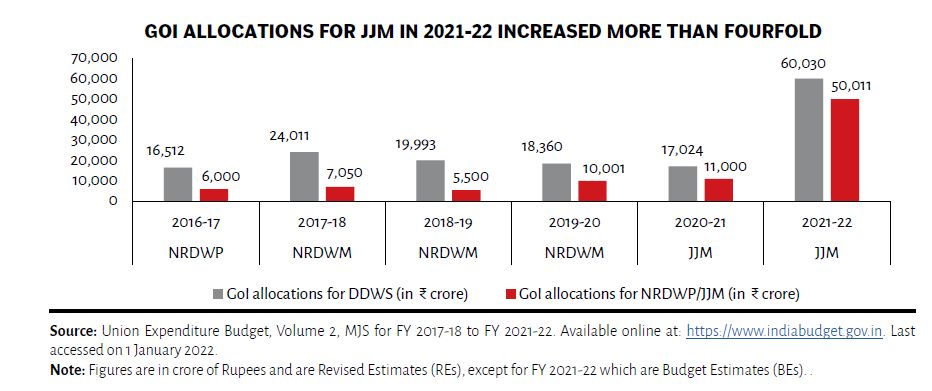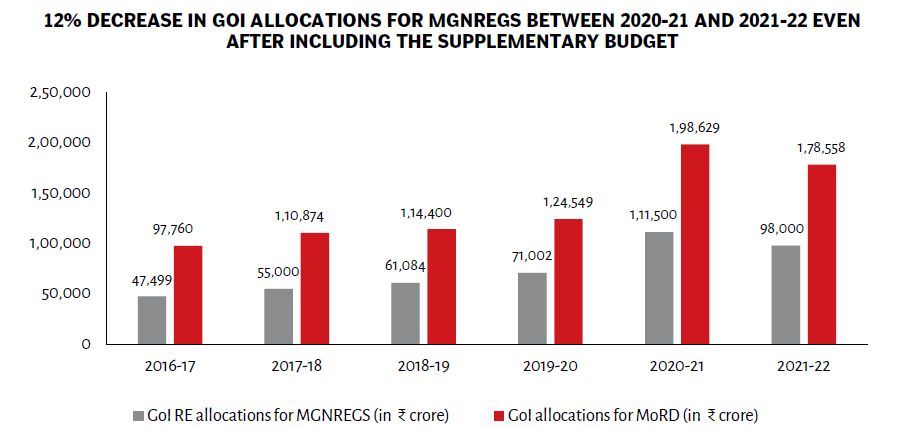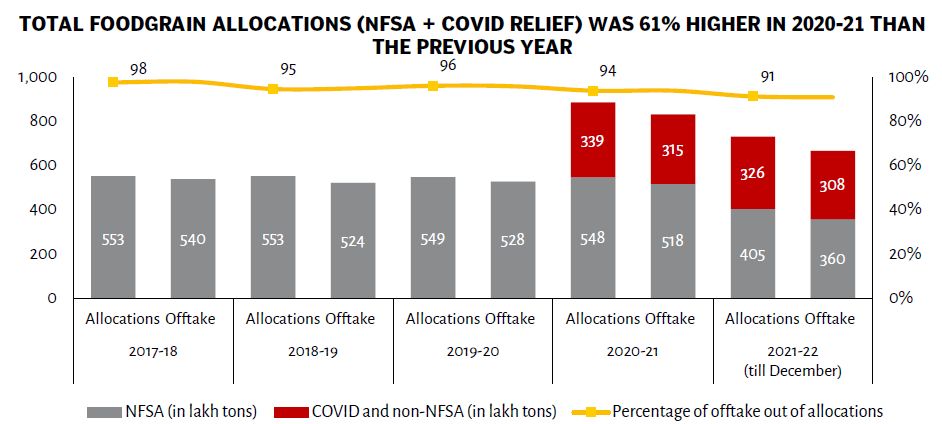
Using government reported data, the briefs analyse trends in allocations, public expenditures, outputs and outcomes of key social sector programmes. These briefs are published in the run-up to the Government of India budget in February every year. The analysis is based on government data on: GoI allocations, releases, and expenditures and progress on coverage and components of various programmes.
Jal Jeevan Mission
Jal Jeevan Mission (JJM) is the Government of India’s (GoI’s) rural drinking water programme to provide functional household tap connections to every household for drinking, cooking, and other domestic needs at a capacity of at least 55 litres per capita, per day (lpcd) by 2024 on a sustainable basis by 2024. It subsumes the previous National Rural Drinking Water Programme (NRDWP) and is implemented by the Department of Drinking Water and Sanitation (DDWS) under the Ministry of Jal Shakti (MJS).
JJM is the largest scheme of DDWS. It accounted for 83 per cent of the total DDWS allocations for Financial Year (FY) 2021-22. In FY 2021-22, GoI allocated Rs. 50,011 crore Budget Estimates (BEs) for JJM – more than a fourfold increase from the Revised Estimates (REs) of FY 2020-21. However, as per the JJM Management Information System (MIS), GoI allocations for the year stood at Rs. 92,309 crores as on 1 January 2022. This implies that REs are likely to be even higher.
Despite this significant increase, release of funds by GoI was slow during the year. By the end of the third quarter, GoI had released Rs. 24,414 crores, 26 per cent of its allocations. There are, however, variations across states. Many states in the North Eastern Region (NER) and Himachal Pradesh had received more than half their GoI share for FY 2021-22 by 1 January 2022. Other states such as Kerala, Gujarat, Odisha, Uttarakhand, and Madhya Pradesh had received 50 per cent of their share each. On the other hand, Andhra Pradesh, Telangana, and Bihar had not received any funds till 1 January 2022. Other states with low releases include Tamil Nadu and West Bengal, which received less than 20 per cent of their share.

Utilisation of funds available is even lower. Till 1 January 2022, 13 states including West Bengal, Jharkhand, and Tamil Nadu had utilised less than half their available GoI funds. However, Himachal Pradesh, Uttar Pradesh, and Haryana had spent more than 70 per cent of their GoI funds available.
18 states/UTs spent less than 50% of their GoI funds available for the 'coverage' component in 2021-22 till 1 January 2022. As on 1 January 2022, less than 2 years away from the completion date, 5.5 crore or 29 per cent rural households have been provided functional household tap connections since the launch of the mission. However, 20 per cent of the targeted households had no access to functional household tap connections.
JJM aims to provide 55 lpcd to households, up from 40 lpcd in the 11th Five Year Plan. In FY 2020-21, 11 states and UTs had coverage of over 80 per cent using the 40 lpcd criterion. As on 1 January 2022, 12 states and UTs had coverage of over 80 per cent, with Bihar also meeting the 40 lpcd criterion. Goa, Gujarat, Telangana, and Puducherry have consistently maintained 100 per cent coverage.
Using the 55 lpcd criterion, as prescribed by the scheme, 6 states and UTs had a coverage of at least 80 per cent of households in FY 2020-21. In FY 2021-22 this further dropped to 5 states and UTs as coverage decreased in Jharkhand and Madhya Pradesh but increased in Bihar. 79% of rural households in India were covered by 40 lpcd and 47 per cent by 55 lpcd till 1 January 2022
The estimated budget for JJM for the five-year period, 2020-24, was set as Rs. 3.6 lakh crore. Of this, GoI's share is Rs. 2.08 lakh crore or 58 per cent. Funding for the same is from direct allocations for the scheme, and those mobilised through Extra Budgetary Resources (EBR).
On 2 October 2020, MJS launched a mission-mode campaign to provide potable PWS in all rural schools and anganwadi centres. 10 states and 5 UTs had 100 per cent piped water supply in their schools and anganwadi centres by 1 January 2022.
The budget brief on Jal Jeevan Mission is available here
Mahatma Gandhi National Rural Employment Guarantee Scheme (MGNREGS)
This is GoI’s flagship scheme to provide at least 100 days of guaranteed wage employment in a financial year to every rural household that demands work. 100 per cent of the unskilled labour cost and 75 per cent of the material cost is borne by GoI. Funds are released by GoI to the State Employment Guarantee Fund (SEGF).
For FY 2021-22 BE, GoI allocated Rs. 73,000 crores to MGNREGS. Even after the inclusion of additional funds amounting to Rs. 25,000 crores via supplementary budgets, allocations were 12 per cent less than the previous year's RE.
Expenditures continued to be higher than the funds available, and by the third quarter of FY 2020-21, 111 per cent of available funds had already been spent by states. Accumulated payments due, known as pending liabilities, had thus risen to Rs. 10,654 crores as on 31 December 2021.
Notified wage rates increased by 4 per cent between FY 2020-21 and FY 2021-22, but actual wages paid remained lower than the notified wage rates for most states till 31 December 2021.
Percentage of unmet demand, which is the difference between employment demanded and employment provided, was highest in April and September 2021 at 33 per cent and 31 per cent, respectively. For FY 2021-22 till 31 December 2021, around 91 lakh households that demanded work had not yet received it.
According to a 2019 survey by the National Statistical Office (NSO), there was not much difference in who participated in the scheme. The proportion of rural agricultural households that undertook work under MGNREGS was similar for the bottom (22 per cent) and top quintile (20 per cent).

The budget brief on Mahatma Gandhi National Rural Employment Guarantee Scheme (MGNREGS) is available here
Pradhan Mantri Kisan Samman Nidhi (PM-KISAN)
Pradhan Mantri KIsan Samman Nidhi (PM-KISAN) is the Government of India’s (GoI’s) income support scheme, under which all landholding farmers receive up to Rs. 6,000 per year to supplement their financial needs. The funds are credited through Direct Benefits Transfer (DBT) mode into the bank accounts of the eligible farmers. Initially, the scheme benefits were provided to Small and Marginal Farmer (SMF) families, who owned cultivable land up to 2 hectares. The coverage was expanded on 1 June 2019 to cover all landholding farmer families irrespective of the size of their landholdings, subject to some exclusion criteria.
PM-KISAN is the largest scheme of the MoAFW, accounting for 49 per cent of the Ministry’s allocations. At the start of FY 2021-22, allocations for the scheme stood at Rs. 65,000 crore BEs. This was a 13 per cent less than the previous year’s BEs, but the same as the REs.

Fund release has been high. In FY 2021-22, till 8 December 2021, GoI had released Rs. 45,250 crores under the scheme, accounting for 70 per cent of the BEs for the year. Including the latest releases on 1 January 2022, as part of the tenth instalment, the figure is estimated to be around Rs. 65,250 crores, which is higher than the BEs for FY 2021-22 by Rs. 250 crores.
As on 3 January 2022, 12.3 crore farmers were registered on the PM-KISAN portal, as compared to 11.45 crore in December 2020. This indicates that 85 lakh new registrations took place in 2021.
There were 44.9 lakh ineligible farmers who received PM-KISAN benefits as on 30 November 2021. Out of these, 27 per cent were income tax payers.
The responsibility of recovery of the amount transferred to ineligible beneficiaries’ rests with the respective state governments. Cumulatively, till 30 November 2021, while Rs. 261 crores have already been recovered, Rs. 3,346 crore remains to be recovered from the ineligible beneficiaries.
The budget brief on Pradhan Mantri Kisan Samman Nidhi (PM-KISAN) is available here
Food Subsidy and the National Food Security Act (NFSA)
Food Subsidy is provided by the GoI for the supply and distribution of foodgrains and other essential commodities. With the passing of the National Food Security Act (NFSA) in 2013, nutritional security became a right. Under the Act, adequate quantities of quality food at affordable prices are to be provided to two-thirds of India’s population.
NFSA legally entitles 75 per cent of the rural and 50 per cent of the urban population to receive subsidised foodgrains under the targeted public distribution scheme. There are two categories of people receiving subsidised grains: a) Antyodaya Anna Yojana (AAY) which constitutes poorest of the poor and entitled to 35 kgs of foodgrains per family, per month, and b) Priority HouseHolds (PHH) identified by states and entitled to 5 kgs per person, per month.
Under NFSA, foodgrains are to be made available at a subsidised rate of Rs. 3 per kg for rice, Rs. 2 per kg for wheat, and Rs. 1 per kg for coarse grains to all AAY and PPH households.
For FY 2021-22 BEs, GoI allocated Rs. 2,56,948 crores to MoCAF&PD. Even after the inclusion of additional funds amounting to Rs. 50,905 crores via supplementary budgets, allocations are 32 per cent less than the previous year's REs.
Food Subsidy is the largest scheme of the Ministry and followed a similar pattern. Allocations for FY 2021-22 BEs stood at Rs. 2,42,836 crores. Despite additional allocations of Rs. 46,513 crores through supplementary budgets, it was still 32 per cent less than the previous year's REs.
Allocations of foodgrains increased significantly in FY 2020-21 and FY 2021-22 owing to the additional allocations made under PMGKAY and other pandemic relief measures. With the extension of PMGKAY into its fifth phase, estimated foodgrain allocations for FY 2021-22 are at a record high of 981 lakh tons, 79 per cent higher than FY 2019-20.

After accumulating a large debt over the years, FCI’s outstanding debt reduced to Rs. 45,572 crores as on 31 December 2021, eightfold lower than the amount incurred on the same date in FY 2020-21. However, with the increase in foodgrains provided by FCI, the debt is likely to increase again in the REs.
As of November 2021, the coverage of eligible beneficiaries under NFSA (calculated using projected populations for 2021) was 87 per cent.
The budget brief on Food Subsidy and the National Food Security Act (NFSA) is available here
Pradhan Mantri Poshan Shakti Nirman (PM POSHAN)
The National Programme of PM POSHAN previously known as the National Scheme for Mid-Day Meals in schools (MDM) is a scheme to provide one hot cooked meal in government and government-aided schools. It aims at improving the nutritional status of students.
In FY 2021-22, GoI allocated Rs. 11,500 crores for PM POSHAN, an 11 per cent decline from previous year's REs. However, to ensure PM POSHAN provisioning during the COVID-19 pandemic, allocations were increased to Rs. 12,700 crores. Despite this increase, allocations remain 48 per cent lower than the MoE's total demand.
Release of funds to states significantly slowed down in FY 2021-22. On average, only 48 per cent of the funds approved were released till December. The figure for the corresponding period in FY 2020-21 was 73 per cent. Moreover, between April to December 2020 and April to December 2021, the total quantum of funds released by GoI for PM POSHAN saw a 30 per cent decline.

Like previous year, in FY 2021-22, MoE announced an additional fund release of Rs. 1,200 crores to provide MDM or Food Security Allowance (FSA) during the summer vacation. The pace of fund release was even slower in FY 2021-22 compared to the previous year.
In FY 2022-23, the scheme is to be expanded to include pre-primary students. As per our estimates, additional funds ranging between Rs. 345 crore and Rs. 374 crore will be needed from GoI to provide meals to the 32 lakh students studying in pre-primary or Bal Vatikas in government and government-aided primary schools.
The budget brief on Pradhan Mantri Poshan Shakti Nirman (PM POSHAN) is available here
/articles/budget-briefs-accountability-initiative-highlights-key-programmes